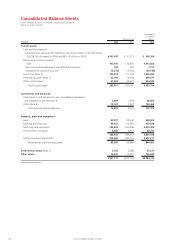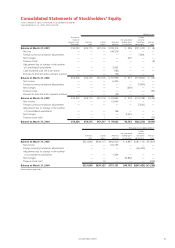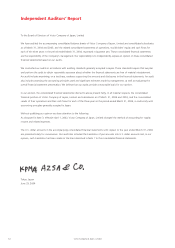JVC 2004 Annual Report Download - page 48
Download and view the complete annual report
Please find page 48 of the 2004 JVC annual report below. You can navigate through the pages in the report by either clicking on the pages listed below, or by using the keyword search tool below to find specific information within the annual report.
Victor Company of Japan, Limited46.
Significant components of the Companies’ deferred tax assets
and liabilities at March 31, 2004 and 2003 are as follows:
Thousands of
Millions of yen U.S. dollars
2004 2003 2004
Deferred tax assets:
Loss on devaluation
of inventory ¥ 4,017 ¥ 5,365 $ 37,896
Accrued expenses not
deductible for tax
purposes 10,028 7,887 94,604
Accrual for losses on
business restructuring 1,269 367 11,972
Depreciation 8,920 8,378 84,151
Retirement and severance
benefits 5,272 2,383 49,736
Tax loss carry forwards 17,746 23,275 167,415
Other 11,295 12,665 106,556
Total gross deferred
tax assets 58,547 60,320 552,330
Less valuation allowance (28,808) (37,026) (271,773)
Net deferred tax assets ¥ 29,739 ¥ 23,294 $ 280,557
Deferred tax liabilities:
Net unrealized holding
gains on securities (3,223) (356) (30,406)
Other (1,299) (1,077) (12,255)
Total gross deferred
tax liabilities ¥ (4,522) ¥ (1,433) $ (42,661)
Net deferred tax assets ¥ 25,217 ¥ 21,861 $ 237,896
8. SHORT-TERM BANK LOANS AND LONG-TERM DEBT
Short-term bank loans of certain of the Company’s consolidated
subsidiaries consist of notes maturing generally in three months.
The applicable annual interest rates on short-term bank loans
outstanding at March 31, 2004 and 2003 range from 0.04% to
10.22% and from 1.26% to 26.42% , respectively.
Long-term debt at March 31, 2004 and 2003 are as follows:
Thousands of
Millions of yen U.S. dollars
2004 2003 2004
1.5% unsecured convertible
bonds due in 2005 ¥ 10,968 ¥11,483 $103,472
0.55% unsecured convertible
bonds due in 2005 19,528 20,000 184,226
1.75% unsecured bonds
due in 2003 —5,000 —
2.15% unsecured bonds
due in 2005 9,500 10,000 89,623
1.68% unsecured bonds
due in 2006 20,000 20,000 188,679
1.89% unsecured bonds
due in 2007 10,000 10,000 94,340
1.50% guaranteed notes
due in 2005 6,864 7,206 64,755
Loans, primarily from banks
with interest principally at
1.19% to 6.10%
Secured —322 —
Unsecured 26,405 34,184 249,103
103,265 118,195 974,198
Less current portion 16,928 12,727 159,698
¥ 86,337 ¥105,468 $814,500
The 1.5% unsecured convertible bonds are redeemable prior
to their stated maturity, in whole or in part, at the option of the
Company at prices ranging from 107% to 100% of the principal
amount. The price at which shares of common stock shall be
issued upon conversion is ¥2,867 ($27.05) per share, subject to
adjustment under certain circumstances. The 0.55% unsecured
convertible bonds are redeemable prior to their stated maturity,
in whole or in part, at the option of the Company at prices
ranging from 103% to 100% of the principal amount. The price
at which shares of common stock shall be issued upon conversion
is ¥1,487 ($14.03) per share, subject to adjustment under
certain circumstances.
The aggregate annual maturities of long-term debt at March
31, 2004 are as follows:
Thousands of
Year ending March 31 Millions of yen U.S. dollars
2005 ¥ 16,928 $159,698
2006 46,016 434,113
2007 30,126 284,208
2008 10,129 95,557
2009 66 622
¥103,265 $974,198
9. EMPLOYEES’ SEVERANCE AND RETIREMENT BENEFITS
Employees of Japanese companies are compulsorily included in the
Welfare Pension Insurance Scheme operated by the government.
Employers are legally required to deduct employees’ welfare
pension insurance contributions from their payroll and to pay
them to the government together with employers’ own contribu-
tions. For companies that have established their own Employees’
Pension Fund which meets certain legal requirements, it is possible
to transfer a part of their welfare pension insurance contributions
(referred to as the substitutional portion of the government’s
scheme) to their own Employees’ Pension Fund under the
government’s permission and supervision.
Based on the newly enacted Defined Benefit Corporate
Pension Law, the Company and its consolidated domestic
subsidiaries decided to restructure their Employees’ Pension
Fund and were permitted by the Minister of Health, Labor and
Welfare on July 1, 2002 to be released from their future obliga-
tion for payments for the substitutional portion of the Welfare
Pension Insurance Scheme. Plan assets for the substitutional
portion maintained by the Employees’ Pension Fund are to be
transferred back to the government.
The Company and its consolidated domestic subsidiaries applied
the transitional provisions as prescribed in paragraph 47-2 of the
JICPA Accounting Committee Report No. 13, “Practical Guideline
for Accounting of Retirement Benefits (Interim Report)”, and the
effect of transferring of the substitutional portion was recognized
on the date permission was received from the Ministry of Health,
Labor and Welfare. As a result, in the year ended March 31, 2003,
the Company and its consolidated domestic subsidiaries recorded
gains on the release from the substitutional portion of the
government’s Welfare Pension Insurance Scheme amounting to
¥3,456 million, which was calculated based on the amounts of the
substitutional portion of the projected benefit obligations, the
related plan assets, and the related unrecognized items.
The amount of plan assets expected to be transferred back to the
government approximated ¥65,305 million as of March 31, 2003.
























